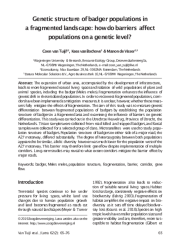Genetic structure of badger populations in a fragmented landscape: how do barriers affect populations on a genetic level?

Abstract: The expansion of urban area, accompanied by the development of infrastructure, leads to more fragmented natural living space and isolation of wild populations of plant and animal species, including the badger (Meles meles). Fragmentation enhances the influence of genetic drift in these isolated populations. In order to reconnect fragmented populations, corridors have been implemented as mitigation measures. It is unclear, however, whether these measures fully mitigate the effects of fragmentation. The aim of this study was to measure genetic differentiation between fragmented populations of badgers by establishing the population structure of badgers in a fragmented area and examining the influence of barriers on genetic differentiation. This study was carried out in the Utrechtse Heuvelrug, Province of Utrecht, the Netherlands. Tissue samples were collected from road killed and trapped badgers, and faecal samples were collected for a selected group of clans. Microsatellites were used to study population structure of badgers. Population structure of badgers on either side of a major road, the A27 motorway, differed substantially. The degree of heterozygosity between both populations appeared to be similar, allelic diversity however was much lower for the population west of the A27 motorway. This barrier may therefore limit gene flow despite implementation of multiple corridors. Long-term studies may reveal to what extent corridors mitigate the barrier effect by major roads.